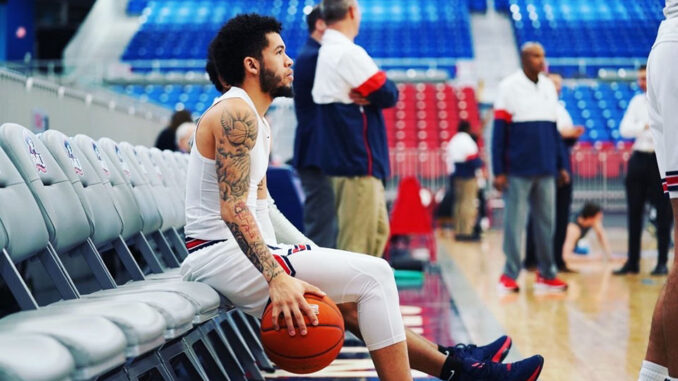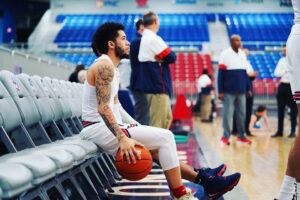

Adam Lindner | Sports Editor
Aug. 27, 2020
The Duquesne men’s basketball team’s 2019-20 campaign ended suddenly on March 12, only hours before the team was set to open play as the Atlantic 10 tournament’s sixth seed. The decision, made in response to the sudden outbreak of COVID-19, came swiftly that Thursday afternoon as conferences across the nation successively announced the cancellations of their championships.
Hours after the A-10’s cancellation, the NCAA announced that its remaining winter and spring championships were called off altogether.
Now months removed, the virus’ proliferation has spawned many grim realities around the globe, and — albeit on a decidedly abbreviated scale — that’s no different for sports, nor their leagues, teams, employees, athletes or supporters. Some, like DU center Baylee Steele, will forever be left wondering what could’ve been had their final college seasons ended naturally.
For Keith Dambrot and his Dukes, the uncertainty and ensuing frustration regarding what would have — could have — transpired had the postseason continued is, and will remain, unresolvable.
Be that as it may, that does not mean the team and its fans shouldn’t take some solace in the campaign. For large portions, it was an encouraging showing, highlighted by a historic 10-0 start, an 11-7 showing in conference play — notching a program record for A-10 wins in a single season — and emboldening road victories over both Saint Louis and St. Bonaventure.
Contrarily, it also saw pedestrian, too-close-for-comfort wins over George Washington, plebeian Fordham (twice) and La Salle. It saw a miserable second-half meltdown at Rhode Island, and regrettable losses against Massachusetts and GW.
The abbreviated season as a whole, though, can largely be marked as a positive development. The team with no true home court began its season with the program’s best record since 1953-54, saw the emergence of forward Marcus Weathers as an all-league player and ended the season with 20-plus victories for just the third time in the last 48 years.
In retrospect, the 2019-20 Dukes’ biggest regret will likely be never knowing just how much they could have achieved. It’s probable that Dambrot would have found his Dukes victorious in the conference tournament for the first time in his three-year tenure at the school, and the possibilities beyond that are vast.
Boasting a season sweep of NCAA Tournament bubble team Saint Louis, two close contests with high-flying Dayton and a gutsy overtime win at VCU, the prospect of a National Invitation Tournament berth was absolutely plausible for Duquesne. The Dukes’ postseason realities would’ve been crystallized given a proper conference tournament, including the slim possibility of a conference title and automatic March Madness bid — which, hypothetically, could have included a Cinderella-type triumph over Obi Toppin and the nationally-renowned Flyers in the league title game.
In another alternate reality, the team could have bounced No. 14 Fordham — which downed No. 11 GW on March 11 in what would eventually be the tourney’s final game — before facing a struggling Rhode Island squad in the quarterfinal round. A win against URI would have put Duquesne in the league’s second semifinal matchup on March 14, likely against No. 2 Richmond or a potentially-surging Davidson team.
After taking care of business against both Fordham and Rhode Island, though, the Dukes would fall one victory short of the title game, which would’ve been the program’s first appearance since 2009. An NIT bid may have very well been thrown Duquesne’s way, though, and the program could have taken solace in the tasting of postseason success for the first time in a while.
Then again, it’s possible, too, that Duquesne would have faltered at the hands of Fordham — a team that the Dukes narrowly beat in two regular-season rock-fights — and moved to 0-3 all-time in the conference tourney under Dambrot. The positive momentum that the regular season generated wouldn’t be nullified, necessarily, but the team’s lack of postseason success would have surely dampened the campaign’s memory, as well as the generally positive feeling regarding the program heading into a pivotal 2020-21 season.
Alas, nobody will ever know with certainty how the Dukes would have fared in the end. The 2019-20 sports season will forever be a mystery for countless teams around the globe; the Dukes are no different.
There were three major developments during the 2019-20 season, however, that indicate the possibility of an unforgettable 2020-21 campaign — if and when that season actually happens.
The foremost of those developments is found in Duquesne point guard Sincere Carry, his promising sophomore season and, most importantly, his self-evident health.
1. Sincere Carry’s health
The criminally-under-recruited Carry found himself with a lack of serious college interest when he graduated high school in 2018, largely as the result of missed time due to knee problems.
A top middle school player, he missed out on all-important time on the AAU circuit throughout high school, and coaches essentially retreated due to his murky injury history. He committed to D-II West Liberty before Duquesne offered, making him a late addition to a sizable 2018 recruiting haul for Dambrot.
He ended up being the gem of the class, taking over lead guard duties from Day One and never looking back. Now halfway through his Duquesne career, it’s obvious to anyone watching that these Dukes will go only as far as Carry can take them.
Carry missed four games during his freshman campaign in 2018-19, and at times appeared hobbled on the court during others. In his absence, the lack of his presence on both sides of the ball was felt by the Dukes, who look to Carry to be the leader of their offensive attack and an energetic tone-setter on D.
Well, good news: He appeared entirely healthy throughout his sophomore season, playing 35.5 minutes per contest across 30 games. He notched a full 40-minute effort at Fordham, and played 40-plus minutes in overtime games versus Fordham (41), at St. Bonaventure (42) and at VCU (42). At no point did Carry appear limited on the floor, offering Duquesne its most encouraging development of the past season.
As a result, the point guard improved his yearly 3-point percentage by 2.1% (to 33.6%) while launching 26 more times from long-range in a season that saw the NCAA move its 3-point line back from a traditional length of 20 feet and 9 inches to 22 feet and 1¾ inches, the customary distance found in international play. Improved long-range shooting was a goal of Carry’s entering his sophomore season; the results have been reassuring. Entering his junior year with a clean bill of health, a growing offensive arsenal and his brother, Mike Bekelja, now in the fold, Carry appears primed to continue ascending as one of the league’s premier guards.
2. Marcus Weathers’ emergence
A major question regarding the team entering the past season was which players would take sizable leaps in their production. It seemed, following the loss of swingman Eric Williams Jr., that a considerable onus of responsibility would fall on the team’s other perimeter scorers in the wake of his departure.
Lamar Norman Jr. fared decently well in an augmented role, and freshman Maceo Austin showed flashes of his budding potential. Tavian Dunn-Martin had some huge moments, highlighted by an unreal individual effort from 3-point range at VCU.
For several periods throughout the season, though, it was forward Marcus Weathers that proved to be a matchup nightmare for innumerable hapless defenders.
As a whole, the redshirt junior:
1. Upped his scoring average from 10.0 points per game to 14.3
2. Improved his field goal percentage from 48.9% to a whopping 55.7% clip while attempting 60 more shots in total
3. Grabbed 8.1 rebounds per game, an improvement from 6.4 per game the year prior
4. Was one of two players to start all 30 games alongside Carry
5. Recorded double-digit points a team-high 21 times
Weathers’ emergence as an all-league talent may have initially caught some by surprise, but his enhanced game was evident from the outset of conference play to those paying attention. He began to produce at an unprecedented level toward the conclusion of non-league competition, posting 19 points and 13 rebounds against Radford on Dec. 14 before scoring 25 points and grabbing 13 boards against Marshall on Dec. 29.
His importance was magnified, though, in conference play, headlined by memorable performances against Saint Louis (twice) and Dayton.
Weathers’ inside-out game proved to be a brutal assignment for many throughout the A-10, and nobody struggled to contain him quite like SLU. Weathers scored 26 points in both of the Dukes’ games against the Billikens on 62.5% shooting, tormenting a team that prides itself upon its defensive versatility and toughness.
Entering his final year of eligibility, Weathers figures to be in win-now mode alongside fellow seniors Dunn-Martin and Mike Hughes. A more consistent jump shot would unlock yet another level of Weathers’ game; he is already a masterful finisher around the rim but can often struggle when shooting from outside the paint.
Regardless, Weathers’ emergence as a top player in the A-10 in 2019-20 was a significant factor in the team’s record-setting campaign. Without his increased production (and seemingly unstoppable spin move), it’s clear Duquesne wouldn’t have fared nearly as well as it did during the past year.
Likewise, the team will need a memorable final act from Weathers in his last season of eligibility in order to reach its goals of Atlantic 10 predominance and an NCAA Tournament appearance.
3. Gallant wins & collective resolve
One of the most impressive factors of Duquesne’s 11-win conference season was the manner in which some of the wins came — and, for what it’s worth, one of its losses.
In one, on the road at Saint Louis, Duquesne managed to beat a solid conference opponent for the second time in just over a month, this time in a hostile environment. The Billikens made runs, cutting their deficit to just two early in the second half, but the Dukes would answer each of SLU’s jabs en route to an imposing 14-point victory.
Just two weeks prior, Duquesne was 5-0 in the A-10 and set for its first pivotal road game of the year at URI. The game saw a promising first half from DU before a monumental collapse, resulting in a 22-point loss following an eight-point halftime lead. It was disheartening for a team that began A-10 play on a surge, and things only became more bleak following a letdown at UMass days later.
The Feb. 5 game at SLU was Duquesne’s first shot at a road game following those two outings, and beyond the implications that the game held in the league’s standings, the game at a raucous Chaifetz Arena was to be a gut check for a program that hasn’t fared well on the road in some time.
The win was, at the time, Dambrot’s most impressive on the road during his tenure at DU.
Victories at St. Bonaventure on Feb. 26 and VCU on March 3, though, may be even more memorable in retrospect.
The Bonaventure game fell at another critical point for the team, then fresh off two straight losses, including a disconcerting home outing against GW on Feb. 19.
The Dukes were entering the latter part of their season, set to face the Bonnies at the Reilly Center before games against George Mason, VCU and Richmond to end the year. At 8-6 in the A-10 before the Bonaventure matchup, the team was in danger of dropping to just one game above .500 as the season was drawing to a close following a 5-0 start.
Duquesne hadn’t won at St. Bonaventure since 2009, losing 11 consecutive games at the Reilly Center before the Feb. 26 matchup. Just weeks earlier, the Bonnies beat Duquesne, 83-80, in a hard-fought game at the UPMC Events Center on the campus of Robert Morris University in Moon Township, one of the Dukes’ temporary homes for their nomadic campaign.
But Carry & Co. answered the bell in unforgettable fashion, with the point guard recording 18 points and a career-high 11 assists en route to a statement win over SBU.
After forcing overtime with a pair of clutch free throws, Carry drew a key charge in overtime, then buried two more free throws at the end of the extra period to give DU an 81-77 win at St. Bonaventure, its first in over a decade.
The win was especially satisfying for longtime Duquesne supporters who’d grown particularly weary of the team’s annual trip to Olean, N.Y., each season. It gave Dambrot his first victory over the Bonnies at Duquesne, leaving him just a win against VCU away from owning a victory against each of the A-10’s other 13 programs during his young tenure.
That win came March 3, giving the Dukes victory No. 11 in the A-10, a school record. It was Duquesne’s first-ever win against VCU in eight attempts, and gave Dambrot a win over each of the league’s other programs. It also gave DU its sixth A-10 road victory on the season, shattering the previous benchmark of four (set multiple times).
Even so, the nature of the win itself was the most remarkable factor of the VCU win.
The Rams, pegged as the conference favorite in preseason polls, enjoyed a decently successful non-conference slate but disappointed in A-10 competition. By the end of the season, VCU remained a talented yet shorthanded group, and continued to struggle mightily against teams it was previously predicted to dominate.
On the Rams’ senior night, a rocking Siegel Center welcomed the Dukes, who found themselves trailing by 12 with 8:14 remaining. Dunn-Martin went on a 3-point rampage in the game’s second half, giving Duquesne second, third and fourth lives when it seemed VCU might finally pull away for good.
Norman Jr., a talented but inconsistent contributor during his sophomore year, sent the game to overtime with a tough drive to the rim in the game’s final seconds.
The Dukes controlled overtime in large part due to timely 3-pointers from Steele and Dunn-Martin, and escaped from VCU with more than just another road victory — the trend of gutsy wins in hostile environments provided tangible evidence that the program is, in fact, in the process of returning to legitimacy.
Following Year 3 of Dambrot’s time at Duquesne, one of the most promising things regarding the program has been its ability to show tremendous resolve in key moments, specifically throughout the 2019-20 season.
For the first time in over a decade, the team is gifted enough to compete at the heights of the A-10 and, when paired with the program’s evident belief that it truly belongs, there is the real prospect of a much richer 2020-21 campaign.
Several moments from Duquesne’s 73-69 loss against Dayton on Jan. 29 showcased the group’s collective resolve in its highest form, exemplified by a 21-6 second half run against the then-No. 7 Flyers. Down 55-36 with just over 13 minutes remaining, the Dukes would cut their deficit to just four before Dayton regained an 11-point lead.
Even then, the team didn’t concede, fighting back to a 71-69 tally before Dayton prevailed.
The character that the team displayed in the face of a national title contender is perhaps one of the season’s most positive occurrences. The problem, as Dambrot may tell you, is the team’s inability to exhibit consistent effort against all of its opponents.
Bad losses against UMass and George Washington killed the Dukes’ hopes of a double-bye in the A-10 tournament, leaving them as the No. 6 seed; a team that could challenge anyone in the league on any given night, yet one that remained prone to losing games it shouldn’t.
The 2020-21 team will be Dambrot’s first with true veteran experience at Duquesne, led by integral seniors Weathers, Dunn-Martin and Hughes, as well as the beyond-his-years Carry.
With the exception of Steele, the team’s entire core is set to return, and will be joined by what seems to be a highly talented class of freshmen. It’ll be Dambrot’s fourth year at the helm of the program — his current contract runs through 2023-24.
If there’s ever a time for Duquesne to do it big, to purge its long-standing NCAA Tournament drought, what greater time than now?
It’s all contingent upon many factors, yes.
Beyond personnel matters, it’s far from a sure thing that the season will even transpire as it’s currently scheduled. If it does, this is nothing short of Duquesne’s time to make history.
Of course, that’s dependent upon Carry’s health, Weathers’ continued improvement and the team’s ability to continue to show up in key moments. An improved level of preparedness against its lesser opponents might help, too.




